Passionfruit
BackPassionfruit vines are a must have for fruit lovers. They are abundant producers capable of providing two main crops of delicious fruit a year – a summer crop that’s borne from spring flowers and, in warmer climates, a winter crop that follows autumn flowers. The fruit can be eaten fresh from the vine, used to flavour desserts and drinks with excess pulp easily frozen to provide a supply at a later date.
Passionfruit vines are also fast growing with lush deep green foliage and attractive flowers that makes them ideal for creating a quick privacy screen or covering a pergola to provide shade. They’re quick to crop too – expect the first fruit within 12 months from planting in warm areas or a little longer in cooler marginal areas.
How to Grow Passionfruit
Passionfruit originate from subtropical South America and thrive in subtropical, tropical and warm temperate areas of Australia. They are best positioned in full sun with protection from strong winds and frost. In cooler areas plant them in front of a north facing wall or paved surface where vines will benefit from the extra warmth that is radiated. Be sure to cover young vines if there’s a risk of frost. As vines grow taller and the main stem turns woody light frosts can be tolerated.
Soggy soils will lead to root rot so make sure the soil is well drained. Incorporate plenty of compost in an area 1-2m wide to enrich the soil. Use it to help mound up the soil to improve drainage if necessary. In heavy soils apply gypsum to further assist with drainage. They prefer an acid soil with a pH of 5.5-6.5. Continually adding organic matter (like compost and manures) will help acidify soils over time but if your soil is alkaline (over pH 7) then apply sulphur to help push things into the acidic zone.
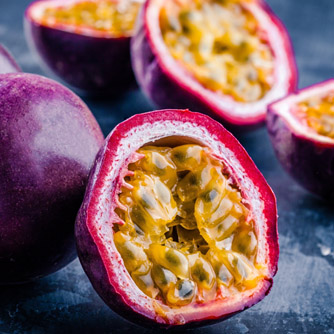
Delicious ripe passionfruit
Passionfruit is a vigorous vine which can grow 3-4m a year when grown in good soils and with adequate water. Even more in hotter areas! This means you need to plant them somewhere that gives them room to grow. While vines can be pruned annually to help contain them they will still need adequate space for their seasonal development. Also make sure that they are grown on a strong support structure eg chain link or weldmesh fences, wires attached to a sturdy timber fence or stretched between a series of free-standing posts. They particularly like growing up and over things, like a solidly built pergola or an old shed as this gives the vines access to plenty of sun and improves fruiting.
Plant passionfruit when there are at least 2-3 months of warm temperatures ahead to ensure they are well established before any cold winter weather. Water in with OCP eco-seaweed then lay down mulch to conserve moisture and suppress weeds. Water daily for the first week or so then gradually cutback.
Many passionfruit vines are self-pollinating so usually you only need one plant however planting two or more vines close by will improve pollination. Check the label of the plant before purchasing in case you have a variety which definitely needs a nearby friend for pollination. Plants are also relatively short lived and a new vine should be established every three years or so to ensure an ongoing supply.
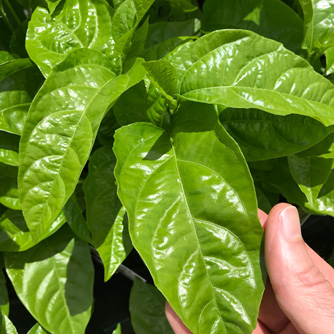
The lush foliage of the passionfruit vine
Top Passionfruit Varieties
- Misty Gem – tough plant with black skinned fruit (subtropical and temperate areas)
- Nellie Kelly – very popular black skinned variety (subtropical and temperate areas)
- Panama Gold – hybrid with yellow skin (subtropical and tropical areas)
- Panama Red – hybrid with red skin (subtropical and tropical areas)
- Sunshine Splash – purple skinned fruit and a prolific producer (subtropical and temperate areas)
- Hawaiian – large yellow skinned fruit with good disease tolerance (subtropical and temperate areas)
- Banana – elongated yellow skinned fruit and pink flowers (temperate areas)
Sowing Guide for Passionfruit
These days many passionfruit plants purchased from nurseries are grafted to improve vigour and reduce disease problems. However most are easy to grow from seed which can be purchased from online suppliers or taken from a fresh fruit. The seed is best taken from a reliable variety, not a hybrid as the resulting fruit may not be true to type. Simply remove the seed from the fruit, take off the pulp surrounding the seed and sow 8-10mm deep in pots filled with premium potting mix. Keep moist in a warm position and seed should germinate in 3-4 weeks.

The amazing passionfruit flower!
| Growing Zone | Sowing Time |
| Cool Zones | Not recommended |
| Mediterranean Zones | Spring, Summer |
| Warm & Temperate Frost Free Zones | Spring, Summer |
| Tropical & Subtropical Zones | Spring, Summer, Autumn, Winter (tropical only) |
Fertilising and Maintaining Passionfruit
Fertilise with manure or organic pellets in early spring and early autumn and apply a dressing of compost around the root zone once a year. Supplement this with fortnightly applications of OCP eco-aminogro and OCP eco-seaweed. If applied as a foliar spray it can help encourage better quality fruit and disease resistance. Monitor pH and if it’s not acidic enough then add some sulphur.
Water vines regularly and deeply during the warmer months especially when plants are in flower and fruit is developing. Just make sure your soil is still draining well otherwise root rot will likely set in.
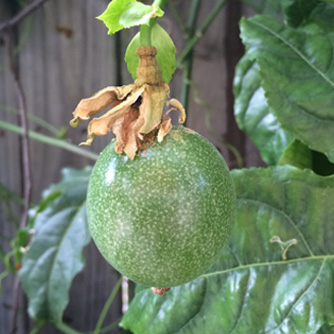
Developing passionfruit takes a long time to ripen
With young plants remove the tips of vines regularly to encourage multiple branching and guide the vines over the structure as required. Trim excessive growth any time throughout the growing season to contain rambling vines or expose flowers and make them more accessible to pollinating insects. More substantial pruning can be done once a year in late winter to early spring to remove bulk and set plants up for the growing season. Cut the crown back to a 1-2m diameter, leaving a few growing tips. This will quickly stimulate new growth on which flowers and fruit will form. Pinch out the growing tips a few times to again encourage multiple branching.
With grafted varieties it is not unusual for shoots with quite narrow lobes on each leaf to appear below the graft union. This sucker growth is vigorous and should be removed immediately or it will take over. The commonly used rootstock does produce edible orange fruit with red pips but it’s not as tasty. Avoid digging around the base of grafted plants as root damage can also cause rootstock suckers to develop as far as a few metres away.
Harvesting Passionfruit
Once fruit is full sized it can still take a long time to ripen so be patient and don’t pick the fruit early! They will fall to the ground when perfectly ripe. Check vines every couple of days when fruit are colouring up and collect what has fallen. Summer harvests are usually sweeter than winter harvest due to the extra sun.
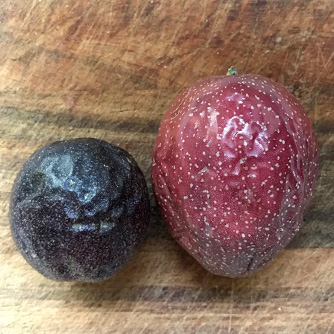
'Panama Red' produces much larger fruit
Pests and Diseases of Passionfruit
- Lack of fruit – pollination can be impacted by bad weather or lack of bees and other pollinators. Work on attracting more pollinators and consider planting another vine which tends to help. Some people will also hand pollination individual flowers if they continue to have low fruit set.
- Fruit drop – usually caused by lack of water during fruit development or being stung by fruit flies (see below).
- Fruit fly – their piercing of the fruit causes premature fruit drop. To monitor for their arrival hang the OCP eco-lure male QLD fruit fly trap and then regularly apply a bait spray once you know they're around. This will protect fruit when it's forming. Alternatively you can use exclusion bags or netting.
- Sap suckers (including mealybug, scale and mites) – these guys will reduced vigour and often cause sooty mould. Spray stems and both sides of the foliage thoroughly with a horticultural oil.
- Fungal leaf diseases – there are several diseases which attack foliage, stems and sometimes the fruit resulting in various brown/black spots, markings or scabs. Try fortnightly foliar sprays of OCP eco-seaweed and OCP eco-aminogro to strengthen the tissue as well as thinning the vine to improve air circulation. If symptoms continue spray with a copper based fungicide.
- Root rot – the phytophthora fungus causes rapid dieback from tips and is a clear sign of poor drainage. Saving the plant is unlikely given the speed of attack. Remove the vine and replace in new ground with improved drainage.
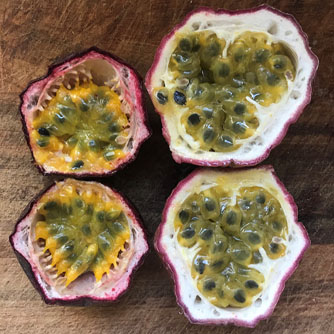
Well grown passionfruits full of seeds surrounded by tasty pulp
- Fusarium wilt – this fungal disease causes rapid collapse of vines and also can’t be easily treated. Best to remove the vine and replace with a grafted variety which has known resistance in a new position.
- Passionfruit woodiness virus – symptoms include yellowing and mottled foliage, deformed fruit with thickened rinds and premature death of vines. Not treatable so destroy plant (do not place in the compost) and plant a new plant in a different position.
- Fruit and banana spotting bugs – wilting shoots and pitted spots on fruit are good indications of these pests which can significantly reduce yield. You may need to bag fruit as they are difficult pests to control. Aim to increase the number of predatory insects that will feed on them by planting a range of flowering plants nearby.
- Fruit piercing moth – to protect fruit against this large moth you can bag individual fruit or net the entire vine. Choose netting which is very fine so birds and other wildlife don’t get caught in it.
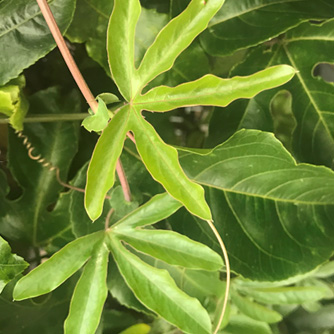
Narrow leaves produced by the rootstock on a grafted passionfruit vine


